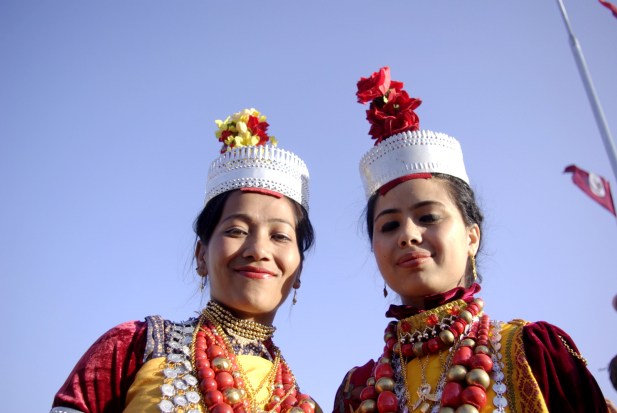Shad Suk Mynsiem
Celebrated in April by the Khasi tribe, Shad Suk Mynsiem — literally meaning “Dance of the Joyful Hearts” — is a thanksgiving festival that marks the end of the sowing season. Men and women dressed in traditional finery dance gracefully to the rhythmic beats of drums and flutes, symbolizing the harmony between man, woman, and nature. The festival, held prominently at the Weiking Grounds in Shillong, celebrates purity, gratitude, and the community’s spiritual connection with the earth.
Nongkrem Dance
Held in November at Smit village near Shillong, the Nongkrem Dance is one of the grandest Khasi festivals. It is performed to thank the Goddess Ka Blei Synshar for peace, prosperity, and a bountiful harvest. The rituals are conducted by the Syiem (chieftain) and the priestesses, followed by the Shad Nongkrem — a captivating dance where women in golden attire and men in traditional warrior costumes move in perfect rhythm. It’s a spectacle of devotion and discipline, celebrating the delicate balance of tradition and faith.

Behdienkhlam
The most important festival of the Jaintia or Pnar tribe, Behdienkhlam is celebrated in July in Jowai. The term means “driving away the plague,” and the festival is rooted in rituals meant to ward off disease and evil spirits. Massive decorated wooden logs called rot are carried through the streets and then immersed in water, accompanied by rhythmic drumming and spirited dancing. A ceremonial football-like game with a wooden ball is played, symbolizing unity and community strength.
Wangala
Known as the Festival of 100 Drums, Wangala is the biggest celebration of the Garo tribe and takes place in October or November. It marks the end of the harvest season and honors Misi Saljong, the Sun God of fertility and bounty. The festival bursts with energy — men and women in vibrant traditional attire dance to the beat of long drums, while chants and horn calls fill the air. Wangala is not just a festival but a cultural spectacle that showcases the rhythmic vitality of Garo heritage.
Chad Sukra
Celebrated by the Jaintia tribe in April or May, Chad Sukra is held just before the sowing season begins. It’s a time to seek blessings for a prosperous agricultural year and protection from calamities. Villagers gather in their finest traditional clothes, offering prayers, performing group dances, and feasting together. The festival reflects the community’s deep-rooted bond with the land and its dependence on the natural cycle of seasons.
Ka Pom-Blang Nongkrem
Closely associated with the Nongkrem Dance, Ka Pom-Blang Nongkrem is another important thanksgiving ritual of the Khasi community. It involves ceremonial offerings to the deity of harvest and fertility to ensure the well-being of both the people and the land. The rituals, passed down through generations, highlight the Khasi matrilineal system and their reverence for divine feminine forces.
Ahaia
Among the Garos, the Ahaia festival marks the start of the sowing season, usually celebrated in March or April. It’s a joyous occasion that brings together music, dance, and rice beer in abundance. Rituals are performed to seek blessings for abundant crops, while songs and dances express gratitude to nature. Ahaia reinforces community ties and reminds people of their harmonious coexistence with the environment.
Do’krua and Mi Amua
These smaller yet meaningful Garo festivals are observed at different points in the agricultural cycle. Do’krua focuses on village renewal and purification, while Mi Amua involves ancestral worship and thanksgiving. Both feature communal feasting, drumming, and dance, serving as reminders of the tribe’s animistic roots and enduring respect for ancestral spirits.
